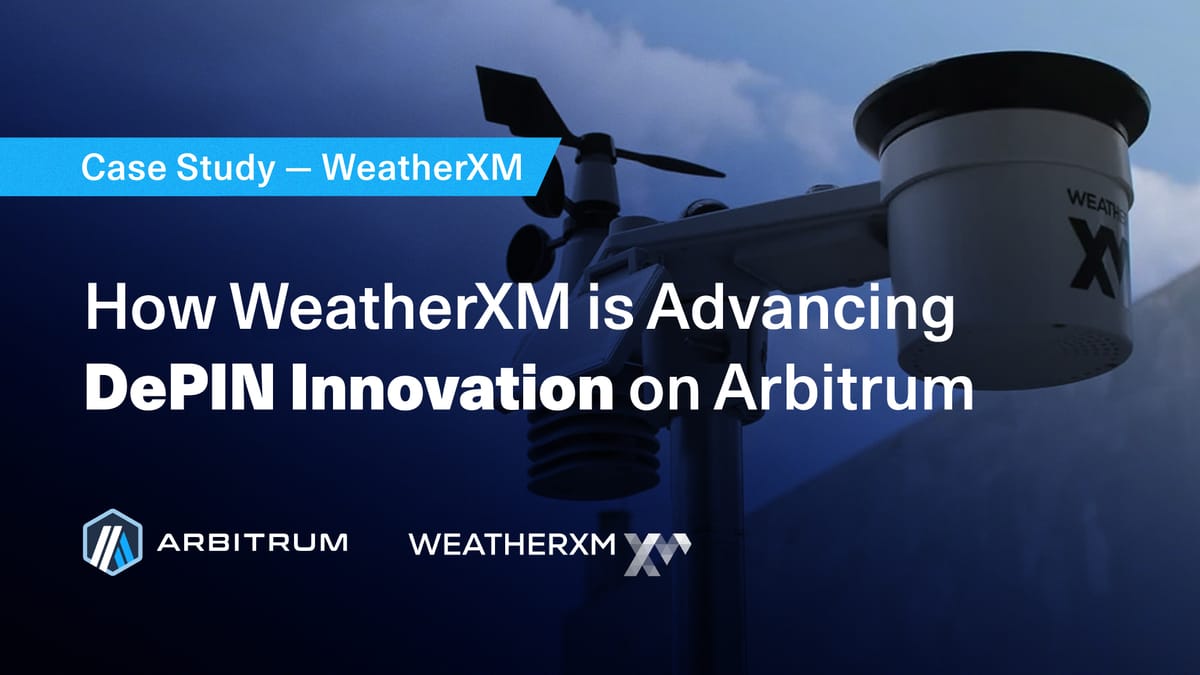How WeatherXM is paving the way for DePIN on Arbitrum

What is WeatherXM
WeatherXM is building a decentralized weather station network, with over 6,000 stations deployed in 80+ countries. WeatherXM uses the blockchain to coordinate weather data collection and rewards users with $WXM tokens based on the data quality they provide and where the weather stations are located. The network's decentralized nature allows for accurate, real-time weather data collection, which can be used for forecasting, insurance, and various DeFi-based financial products.
What Is DePIN?
The rapid emergence of Decentralized Physical Infrastructure Networks (DePIN) is reshaping our thinking about infrastructure. Leveraging the power of blockchain, DePIN enables the decentralized coordination of physical and digital resources like GPUs, sensors, and weather stations to create highly scalable, efficient networks. In this case study, we examine how WeatherXM is making strides in Arbitrum’s DePIN ecosystem.
Case Study
The Opportunity: Ground-based weather data
In today's weather forecasting space, there is a crucial gap in weather infrastructure: the lack of ground-based weather data. Not having enough ground-based weather data weakens weather forecasts' accuracy and affects industries such as agriculture and energy. These industries rely on precise weather predictions and lose billions annually due to inaccurate data, leading to resource wastage. Additionally, current weather stations, typically managed by governments, are expensive, inefficient, and often produce incomplete data, especially in underserved regions.
The Solution:
WeatherXM seized an opportunity to use blockchain technology to address the lack of ground-based weather data. Their vision is to empower communities to deploy affordable, easy-to-install weather stations, creating a large-scale, dense, real-time data collection network. Currently, the WeatherXM Network Association is the owner of all the weather data, and it sells yearly licenses via auction to anyone who is interested in commercializing the data. WeatherXM AG, the company, is buying the data and sells advanced b2b weather services to enterprises to attract more weather-related enterprises and build an ecosystem around the network data.
There are currently three different types of WeatherXM Devices: WeatherXM Helium Version, WeatherXM D1 WiFi bundle (WB1200), and the WeatherXM Pulse 4G bundle (WB3000). Anyone who wishes to participate can follow detailed instructions to install these devices in their buildings or neighborhoods.
Blockchain technology is critical to enabling community members to participate in providing accurate weather data while ensuring no bad players are gaming the system. Users who install and maintain their weather devices are rewarded with $WXM tokens. Since June, station owners have been rewarded with more than 3 million $WXM, based on the quality and reliability of their data, and the team itself ensures a high standard for information collection, drastically improving the precision of hyperlocal forecasts.
To ensure that transaction costs are minimized and there is low latency on the network, WeatherXM decided to deploy on Arbitrum One. Manolis Nikiforakis, the CEO of WeatherXM, said that its decision to move to Arbitrum One was driven by the vibrant and innovative DeFi ecosystem that already exists in the community, noting that this was vital to their goals of developing parametric weather insurance and weather derivatives.
Although the full benefits of the network have yet to materialize, WeatherXM is laying the groundwork for future growth in a supportive ecosystem and has been actively working on pilot programs with partners. WeatherXM has already collected nearly 3 million station-days, a valuable dataset that is growing every single day. Research institutions such as Aristotle University of Thessaloniki have already been tapping into this data, and some of WeatherXM’s stations were used during the Paris 2024 Olympics as part of a research project.
Additionally, WeatherXM already has over 6,000 stations across 80 different countries and has ambitious goals to grow to over 50,000 stations by 2025, becoming one of the largest weather networks globally. This model also extends its impact to underdeveloped regions, where improved weather forecasting can lead to significant social and economic benefits, such as better disaster preparedness and agricultural planning and the company runs special programs to accelerate this transformation through controlled rollouts. Their first experiment is currently in progress, delivering 2270 weather stations in LatAm, Africa and India. You can read more about this effort in their blog or join their vibrant discord community of 15k crypto-weather enthusiasts to learn more about this real-world crypto project.
